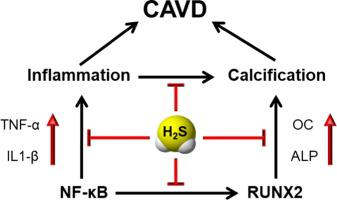Journal of Advanced Research ( IF 11.4 ) Pub Date : 2020-07-21 , DOI: 10.1016/j.jare.2020.07.005 Katalin Éva Sikura 1, 2 , Zsolt Combi 1, 2 , László Potor 1, 2 , Tamás Szerafin 3 , Zoltán Hendrik 1, 4 , Gábor Méhes 4 , Péter Gergely 5 , Matthew Whiteman 6 , Lívia Beke 4 , Ibolya Fürtös 1 , György Balla 2, 7 , József Balla 1, 2

|
Introduction
Hydrogen sulfide (H2S) was revealed to inhibit aortic valve calcification and inflammation was implicated in the pathogenesis of calcific aortic valve disease (CAVD).
Objectives
We investigate whether H2S inhibits mineralization via abolishing inflammation.
Methods and results
Expression of pro-inflammatory cytokines, interleukin-1β (IL-1β) and tumor necrosis factor α (TNF-α) were increased in patients with CAVD and in calcified aortic valve of ApoE-/- mice. Administration of H22S releasing donor (4-methoxyphenyl piperidinylphosphinodithioc acid (AP72)) exhibited inhibition on both calcification and inflammation in aortic valve of apolipoprotein E knockout mice (ApoE-/-) mice is reflected by lowering IL-1β and TNF-α levels. Accordingly, AP72 prevented the accumulation of extracellular calcium deposition and decreased nuclear translocation of nuclear factor-κB (NF-κB) in human valvular interstitial cells (VIC). This was also accompanied by reduced cytokine response. Double-silencing of endogenous H2S producing enzymes, Cystathionine gamma-lyase (CSE) and Cystathionine beta-synthase (CBS) in VIC exerted enhanced mineralization and higher levels of IL-1β and TNF-α. Importantly, silencing NF-κB gene or its pharmacological inhibition prevented nuclear translocation of runt-related transcription factor 2 (Runx2) and subsequently the calcification of human VIC. Increased levels of NF-κB and Runx2 and their nuclear accumulation occurred in ApoE-/- mice with a high-fat diet. Administration of AP72 decreased the expression of NF-κB and prevented its nuclear translocation in VIC of ApoE-/- mice on a high-fat diet, and that was accompanied by a lowered pro-inflammatory cytokine level. Similarly, activation of Runx2 did not occur in VIC of ApoE-/- mice treated with H2S donor. Employing Stimulated Emission Depletion (STED) nanoscopy, a strong colocalization of NF-κB and Runx2 was detected during the progression of valvular calcification.
Conclusions
Hydrogen sulfide inhibits inflammation and calcification of aortic valve. Our study suggests that the regulation of Runx2 by hydrogen sulfide (CSE/CBS) occurs via NF-κB establishing a link between inflammation and mineralization in vascular calcification.
中文翻译:

硫化氢通过NF-κB调节RUNX2抑制心脏主动脉瓣钙化,NF-κB是炎症和矿化之间的联系
介绍
硫化氢 (H 2 S) 可抑制主动脉瓣钙化,炎症与钙化性主动脉瓣疾病 (CAVD) 的发病机制有关。
目标
我们研究 H 2 S 是否通过消除炎症来抑制矿化。
方法和结果
在 CAVD 患者和 ApoE-/- 小鼠的钙化主动脉瓣中,促炎细胞因子、白细胞介素 1β (IL-1β) 和肿瘤坏死因子 α (TNF-α) 的表达增加。H 2 2 S 释放供体(4-甲氧基苯基哌啶基二硫代膦酸(AP72))对载脂蛋白E敲除小鼠(ApoE-/-)小鼠主动脉瓣钙化和炎症的抑制通过降低IL-1β和TNF-来反映α 水平。因此,AP72 阻止了人瓣膜间质细胞 (VIC) 中细胞外钙沉积的积累并减少了核因子-κB (NF-κB) 的核转位。这也伴随着减少的细胞因子反应。内源性 H 2的双重沉默VIC 中产生 S 的酶、胱硫醚 γ-裂解酶 (CSE) 和胱硫醚 β-合酶 (CBS) 发挥增强的矿化作用和更高水平的 IL-1β 和 TNF-α。重要的是,沉默 NF-κB 基因或其药理学抑制阻止了 runt 相关转录因子 2 (Runx2) 的核转位,并随后阻止了人类 VIC 的钙化。在高脂饮食的 ApoE-/- 小鼠中,NF-κB 和 Runx2 水平的升高及其核积累发生。在高脂饮食的 ApoE-/- 小鼠的 VIC 中,AP72 的表达降低了 NF-κB 的表达并阻止其核转位,并伴随着促炎细胞因子水平的降低。类似地,在用 H 2处理的 ApoE-/- 小鼠的 VIC 中未发生 Runx2 的激活S 捐赠者。采用受激发射耗竭 (STED) 纳米镜检查,在瓣膜钙化的进展过程中检测到 NF-κB 和 Runx2 的强烈共定位。
结论
硫化氢抑制主动脉瓣的炎症和钙化。我们的研究表明,硫化氢 (CSE/CBS) 对 Runx2 的调节通过 NF-κB 发生,从而在血管钙化中建立炎症和矿化之间的联系。











































 京公网安备 11010802027423号
京公网安备 11010802027423号